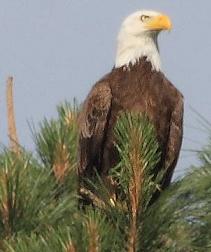Bald Eagle 
U.S. national bird
Identification and Pictures
(Haliaeetus leucocephalus)
Bald Eagles, the majestic national bird of the
U.S. are 30 to 43 inches with a wing span of 6 to 8
feet. The white head and the white tail stand out
against the dark body. The large, powerful, yellow beak,
and large taloned feet are typical of birds of prey that eat
animals, and tare meat. They have piercing, bright yellow
eyes.
Males and females are identical in plumage, but the females
are quite a bit larger than males.
Young birds are often mistaken for Golden
Eagles. They have mottled brown plumage speckled with white,
white on the belly, and yellow feet. They do not get the white head, and
tail like the adults until the 4th or 5th year. The Bald
eagle's average life span is 20 years in the wild, but they may live
30 or more years.
Photos by Keith
Lee. The camera I use is the Canon
EOS 40D. Visit All-birds store

The birds are very powerful flyers, flying with deep strokes and
often soaring with flattened wings on thermal convection currents.
Bald Eagle sound
The eagles call consists of weak chirping whistles.
The voice is a sharp high pitched cackle like
kleek-kik-ik-ik or a lower kak-kak.
Preferred Habitat
Bald Eagles can be found across Canada, and the U.S.
They live along rivers, coasts, lakes, in the mountains, and
open country. They prefer to stay away from
humans. The availability of a food supply determines if
they migrate or not. If their territory gives access to water with
fish year round they will stay all year. If the water
freezes over and they can't get enough food, they will migrate south to warmer country.
Breeding and Nesting
Bald Eagles mate for life. Their courtship involves elaborate calls and flight displays.
During this flight they do swoops, and chase each other through
rapid turns and dives. In a cartwheel flight the birds
will fly high, lock talons, and free fall, tumbling toward the
ground, and separating just
before they reach the ground. They need old-growth stands of coniferous or hardwood trees for perching, roosting, and nesting.
Both birds together will build a nest of sticks, lined with
fine wood materials. The nest may be on a cliff or on the
ground, but is usually in a large tree, giving them view of
their territory. Bald eagles are very territorial, and
will defend a territory of 1 to 2 miles during nesting season. The nest which can be 8 feet wide,
and 12 feet deep is the largest nest of any North American
bird. They will normally use the same nest each year,
adding more sticks each year, creating a nest that can weigh
as much as 2 tons. The female will lay 1 to 3 white eggs, and both
birds will incubate them for around 35 days. Both parents will
care for the young birds, which may not fledge for 12
weeks. Often only one eaglet will survive because an
older sibling may either kill a younger one or keep it from
getting food. The
eagles will fiercely defend the eggs, and young from predators
such as crows, raccoons and magpies.
Food
Bald Eagles hunt for fish in rivers, lakes, and
other bodies of water. They hunt fish by swooping down, and snatching the fish out of the water with
their talons. They are opportunistic, and will kill other animals, and birds
for food as well as feed on carrion. They will also
steal food from other birds, and mammals. Sometimes Bald Eagles
hunt cooperatively, with one bird flushing prey out while the
other attacks it.
To learn about other favorite
birds click here.
|
